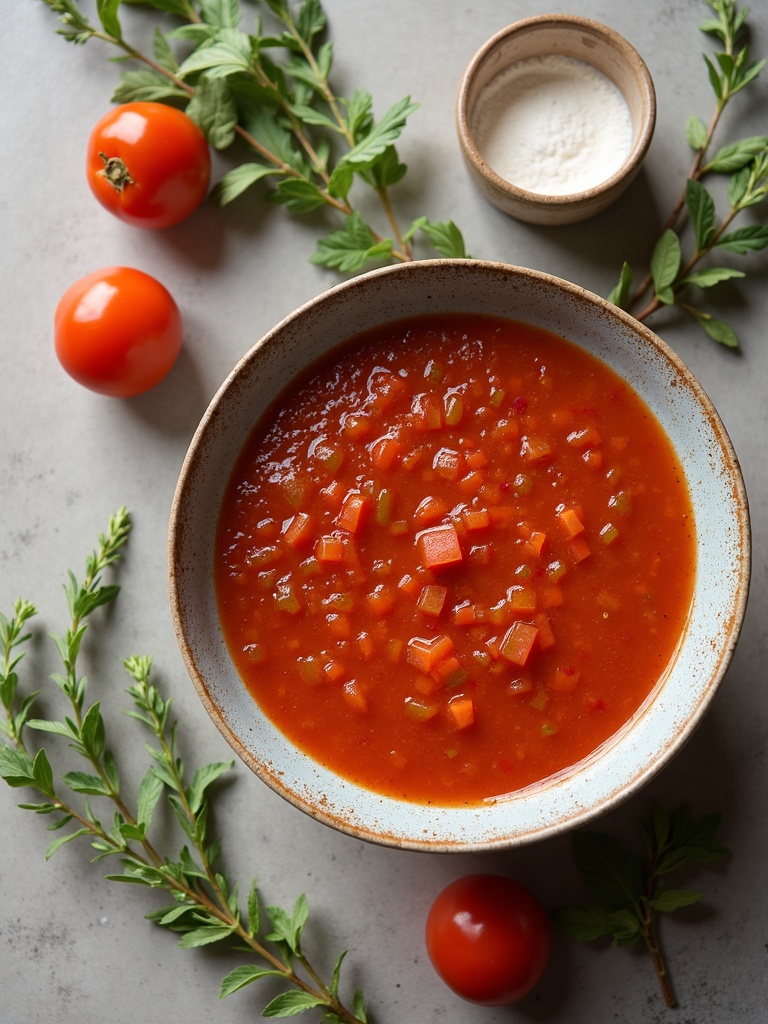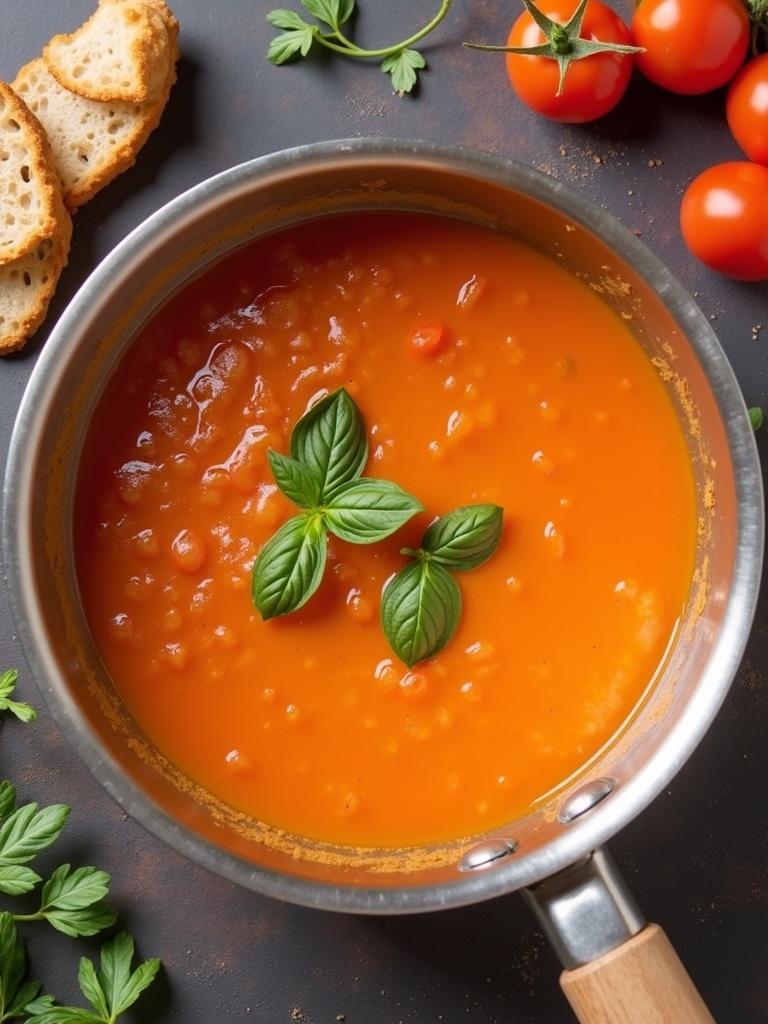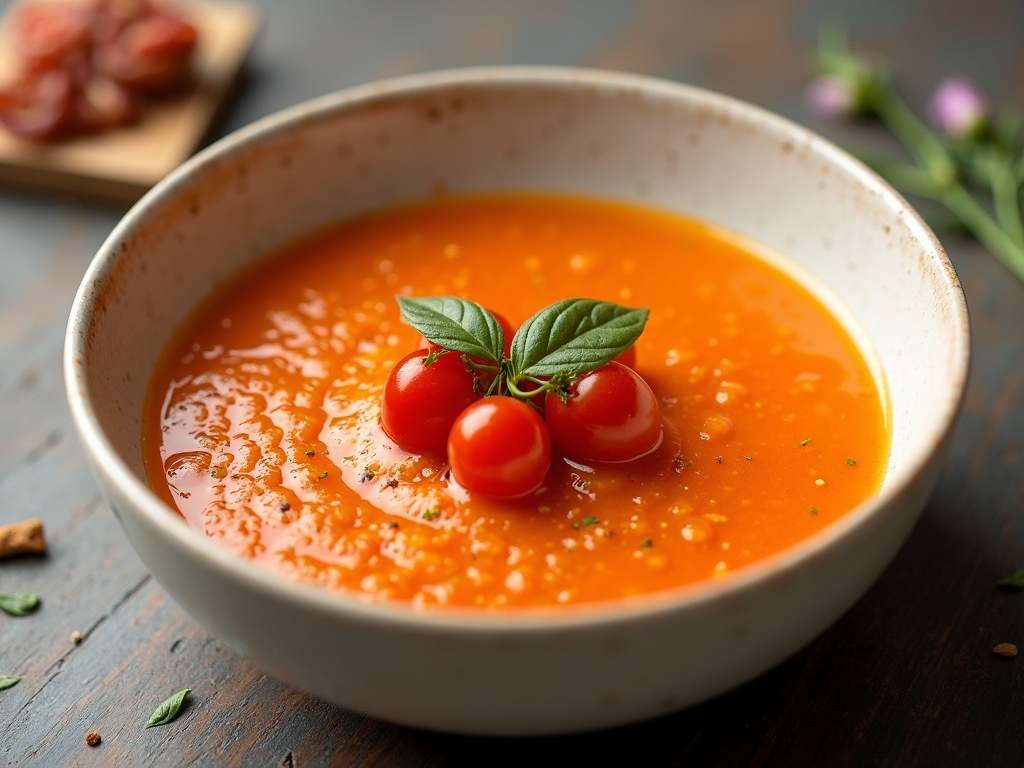Introduction
On scorching summer days, nothing satisfies quite like a bowl of refreshing gazpacho. This vibrant Spanish cold soup celebrates the best of summer produce, transforming ripe tomatoes and crisp vegetables into a silky, flavorful delicacy that requires zero cooking. Originating from Andalusia, gazpacho has evolved from a humble peasant dish to an internationally beloved summer staple. Whether you’re looking to impress guests at your next gathering or simply want to enjoy a nutritious, no-cook option, gazpacho soup delivers extraordinary flavor with minimal effort. Let’s dive into this classic recipe that captures the essence of Mediterranean sunshine in every spoonful.
Table of Contents
Ingredients You Will Need

For the perfect gazpacho, you’ll need ingredients that sing with freshness and vibrancy:
- 2 pounds (about 6-7 medium) ripe tomatoes, preferably heirloom or vine-ripened
- 1 medium cucumber, peeled and roughly chopped
- 1 red bell pepper, seeded and roughly chopped
- 1 small red onion, roughly chopped
- 2 garlic cloves, peeled
- ¼ cup extra virgin olive oil (Spanish varieties work best)
- 2 tablespoons sherry vinegar (can substitute with red wine vinegar)
- 1 slice day-old bread, crusts removed and soaked in water
- 1 teaspoon sea salt, or to taste
- ½ teaspoon freshly ground black pepper
- ¼ teaspoon ground cumin (optional but authentic)
For garnish:
- Finely diced cucumber, bell pepper, and red onion
- Small cubes of crusty bread (for homemade croutons)
- A drizzle of high-quality olive oil
- Fresh herbs like basil or parsley
Ingredient substitutions:
- If tomatoes aren’t in season, use 1 can (28 oz) of high-quality whole peeled tomatoes
- English cucumbers can replace regular cucumbers for fewer seeds
- Green bell peppers work as a substitute for red, though they’ll create a less sweet flavor profile
- Apple cider vinegar can stand in for sherry vinegar in a pinch
Timing
Preparing authentic gazpacho requires minimal active time but benefits from patience:
- Preparation time: 20 minutes (chopping and assembling)
- Blending time: 5 minutes
- Chilling time: Minimum 2 hours (though 4+ hours or overnight yields the best flavor development)
- Total time: 2 hours 25 minutes minimum
Compared to other cold soups, gazpacho is remarkably efficient—it requires 30% less active preparation time than many chilled vegetable soups while delivering maximum flavor. The beauty of this recipe lies in how the flavors intensify during refrigeration, making it an ideal make-ahead dish that actually improves with time.
Step-by-Step Instructions

Step 1: Prepare Your Tomatoes
Core and quarter your tomatoes, removing any tough stem areas. If using regular (non-heirloom) tomatoes with thick skins, you might want to blanch them first: score an X on the bottom of each tomato, drop in boiling water for 30 seconds, then transfer to an ice bath. The skins will slip off easily. For maximum flavor, save any tomato juices that escape during cutting.
Step 2: Soak Your Bread
Take your day-old bread slice and remove the crust. Tear the bread into chunks and place in a small bowl. Sprinkle with a tablespoon of water or a splash of the tomato juice and let it soak for about 5 minutes until softened. This traditional technique, called “adding a sopako,” gives your gazpacho body and silky texture without adding cream.
Step 3: Rough Chop Your Vegetables
Roughly chop the cucumber, bell pepper, red onion, and peel the garlic cloves. Don’t worry about making perfect cuts since everything will be blended. If you prefer a less intense garlic flavor, you can lightly smash and soak the garlic in cold water for 5 minutes before using.
Step 4: Blend In Batches
Working in batches if necessary, add the tomatoes, soaked bread, cucumber, bell pepper, red onion, garlic, olive oil, vinegar, salt, pepper, and cumin (if using) to your blender. Start on low speed and gradually increase to high, blending until smooth. A high-powered blender will create the silkiest texture, but a regular blender works fine—you’ll just blend a bit longer.
Step 5: Strain For Silky Texture (Optional)
For restaurant-quality gazpacho, pass the blended mixture through a fine-mesh sieve, pushing it through with a rubber spatula. This step is optional but removes any remaining seeds or fibrous bits for an ultra-smooth soup. If you prefer a more rustic texture, skip this step.
Step 6: Adjust Seasoning
Taste your gazpacho and adjust the seasoning. Remember that cold foods often need more seasoning than hot ones, so be generous with salt. You may want to add more vinegar for brightness or a touch more olive oil for richness. The flavors should be vibrant and well-balanced.
Step 7: Chill Thoroughly
Transfer your gazpacho to a covered container and refrigerate for at least 2 hours, though overnight is ideal. The flavors will meld and intensify during this resting period. The cold temperature also slightly thickens the soup and enhances its refreshing quality.
Step 8: Prepare Garnishes
While the soup chills, prepare your garnishes. Finely dice some cucumber, bell pepper, and red onion. If making homemade croutons, cube some bread and toss with olive oil, salt, and herbs, then toast until golden in a 350°F oven or skillet.
Step 9: Serve With Style
When ready to serve, give your chilled gazpacho a final stir. Pour into chilled bowls or glasses (serving in stemmed glassware makes for an elegant presentation). Top with your prepared garnishes, a drizzle of your best olive oil, and perhaps a few leaves of fresh herbs. Serve immediately while cold.

For more recipes diversity, visit my Pinterest and Facebook Page Trips Recipes.
Nutritional Information
A typical serving (1 cup) of gazpacho offers impressive nutritional benefits:
- Calories: 120 per cup
- Protein: 2g
- Fat: 7g (primarily heart-healthy monounsaturated fats from olive oil)
- Carbohydrates: 12g
- Fiber: 3g
- Sugar: 7g (naturally occurring from vegetables)
- Vitamin C: 45% of daily value
- Vitamin A: 30% of daily value
- Potassium: 15% of daily value
- Sodium: 480mg (varies based on added salt)
Gazpacho stands out nutritionally compared to other soups:
- 70% fewer calories than creamy vegetable soups
- 90% less sodium than typical canned soups
- Higher antioxidant content due to raw vegetables
- Contains lycopene from tomatoes, which studies link to reduced cancer risk
Healthier Alternatives for the Recipe
Gazpacho is already quite healthy, but here are some ways to modify it for specific dietary needs:
- Lower sodium: Reduce salt and add fresh herbs like basil or cilantro for flavor
- Lower fat: Decrease olive oil to 2 tablespoons and increase vinegar slightly
- Higher protein: Add 1/4 cup hemp seeds when blending or top with Greek yogurt
- Lower carb: Skip the bread completely for a naturally gluten-free and keto-friendly version
- Nightshade-free: Create a green gazpacho using cucumbers, green grapes, avocado, and green herbs
- Extra fiber: Leave some vegetables unblended for texture or add chia seeds
- Heart-healthy boost: Include 1/4 avocado when blending for additional healthy fats
- Anti-inflammatory: Add 1/2 teaspoon turmeric and a pinch of black pepper
Serving Suggestions
Take your gazpacho experience to the next level with these creative serving ideas:
- Serve in chilled shot glasses as an elegant appetizer at summer gatherings
- Pour over ice in a cocktail glass and garnish with a lemon twist for a sophisticated mocktail effect
- Use as a fresh sauce over grilled fish or chicken
- Serve alongside Spanish-inspired tapas like olives, manchego cheese, and almonds
- Pour over diced avocado in a bowl for added creaminess and substance
- Offer a “gazpacho bar” where guests can add their preferred garnishes
- Freeze in popsicle molds for a unique, savory frozen treat on hot days
- Use as a base for a cold noodle salad by adding cooked and chilled pasta
Common Mistakes to Avoid
Even with simple recipes like gazpacho, these pitfalls can affect your results:
- Using underripe tomatoes: This leads to lackluster flavor; only use tomatoes at peak ripeness
- Over-blending: This can create foam and oxidation; pulse carefully until just smooth
- Serving immediately after preparation: Allow at least 2 hours of chilling time for flavors to develop
- Skimping on good olive oil: The quality of your olive oil significantly impacts the final taste
- Underseasoning: Cold foods need more seasoning; be generous with salt and acid
- Using bitter vegetables: Taste your bell peppers and cucumbers before adding—bitterness can ruin your soup
- Adding too many garlic cloves: Raw garlic can easily overpower; start with less and adjust to taste
- Using a weak blender: This makes it hard to achieve that silky texture; blend in smaller batches if needed
- Forgetting to strain: Seeds and skins can create an unrefined texture in traditional gazpacho
- Not adjusting acid: Every batch of tomatoes differs in natural acidity; taste and adjust vinegar accordingly
Storing Tips for the Recipe
Keep your gazpacho fresh and delicious with these storage recommendations:
- Refrigerator storage: Gazpacho keeps well in an airtight container for up to 3 days
- Freezer storage: While not ideal due to texture changes, you can freeze gazpacho for up to 1 month
- Separation is normal: Give your stored soup a good stir before serving
- Store garnishes separately: Keep prepared garnishes in separate containers to maintain their crispness
- Glass containers work best: They don’t absorb flavors or discolor like plastic might
- Portion before storing: Consider freezing in individual portions for easy single servings
- Add a protective layer: A thin drizzle of olive oil on top helps prevent oxidation during storage
- Revitalize leftover gazpacho: Add a splash of fresh vinegar and a few fresh herb leaves before serving
- Allow to warm slightly: Extremely cold temperatures can dull flavors; let sit 5 minutes before serving leftovers
Conclusion
Gazpacho represents the essence of Mediterranean summer cooking—simple ingredients transformed through minimal intervention into something extraordinary. This no-cook wonder celebrates produce at its peak, offering a cooling respite on hot days while delivering impressive nutritional benefits. The beauty of gazpacho lies in its versatility—it can be an elegant dinner party starter, a light lunch, or even a unique base for creative culinary experiments.
I encourage you to make this recipe your own. Experiment with heirloom tomato varieties, play with the garnishes, or try regional variations like white gazpacho using almonds and grapes. Whatever direction you take, the fundamentals remain: fresh ingredients, proper chilling time, and balanced seasoning.
Why not prepare a batch this weekend? Your future self will thank you when you open the refrigerator on a sweltering afternoon to find this refreshing, ready-to-serve soup waiting. Share your gazpacho creations or questions in the comments—I’d love to hear how your culinary adventure unfolds!
FAQs
Is gazpacho served hot or cold?
Gazpacho is traditionally served cold. It’s specifically designed as a refreshing summer soup that requires no cooking, making it perfect for hot weather. Serving it thoroughly chilled (around 40°F/4°C) enhances its refreshing qualities and allows the flavors to fully develop.
Why is my gazpacho foamy?
Foamy gazpacho typically results from over-blending, which incorporates too much air. To avoid this, blend in short pulses rather than continuous blending. If foam appears, let the soup rest in the refrigerator for a few hours—the foam will rise to the top and can be skimmed off.
What can I use instead of bread in gazpacho?
For gluten-free or lower-carb options, you can substitute the bread with half an avocado, a quarter cup of ground almonds, or simply omit it altogether. The bread traditionally adds body and creaminess, but many modern gazpacho recipes skip it entirely for a lighter, more vegetable-forward soup.
How do I fix gazpacho that’s too acidic?
If your gazpacho tastes too acidic, add a pinch of sugar (or a drizzle of honey) to balance the flavors. Alternatively, include more olive oil or a small amount of avocado when blending, as fats help counteract acidity. Remember to adjust gradually and taste as you go.
What’s the difference between gazpacho and salmorejo?
While both are cold Spanish tomato soups, gazpacho typically contains various vegetables (cucumber, bell pepper, onion) and is thinner in consistency. Salmorejo comes specifically from Córdoba, contains only tomatoes, bread, oil, garlic, and vinegar, and has a thicker, creamier texture. It’s traditionally garnished with hard-boiled egg and ham.

Gazpacho Recipes
- Total Time: PT2H25M
- Yield: 6 servings
- Diet: Vegetarian
Description
A refreshing Spanish cold soup made with ripe tomatoes and fresh vegetables, perfect for hot summer days.
Ingredients
For the perfect gazpacho, you’ll need ingredients that sing with freshness and vibrancy:
- 2 pounds (about 6–7 medium) ripe tomatoes, preferably heirloom or vine-ripened
- 1 medium cucumber, peeled and roughly chopped
- 1 red bell pepper, seeded and roughly chopped
- 1 small red onion, roughly chopped
- 2 garlic cloves, peeled
- ¼ cup extra virgin olive oil (Spanish varieties work best)
- 2 tablespoons sherry vinegar (can substitute with red wine vinegar)
- 1 slice day-old bread, crusts removed and soaked in water
- 1 teaspoon sea salt, or to taste
- ½ teaspoon freshly ground black pepper
- ¼ teaspoon ground cumin (optional but authentic)
For garnish:
- Finely diced cucumber, bell pepper, and red onion
- Small cubes of crusty bread (for homemade croutons)
- A drizzle of high-quality olive oil
- Fresh herbs like basil or parsley
Instructions
-
Prepare Tomatoes
Core and quarter tomatoes, removing stems. Optionally blanch and peel for smoother texture. Save any juices for added flavor. -
Soak Bread
Tear crustless day-old bread into chunks and soak with water or tomato juice for 5 minutes until soft. -
Chop Veggies
Roughly chop cucumber, bell pepper, red onion, and garlic. Precision isn’t needed since it will all be blended. -
Blend Ingredients
Blend tomatoes, soaked bread, vegetables, olive oil, vinegar, and spices until smooth. Use a high-powered blender for best texture. -
Strain (Optional)
Strain the blended soup through a fine-mesh sieve for a silky texture, or skip for a more rustic version. -
Adjust Seasoning
Taste and fine-tune with extra salt, vinegar, or olive oil to balance the flavors—cold soups often need more seasoning. -
Chill Thoroughly
Refrigerate for at least 2 hours (or overnight) to let the flavors meld and the soup thicken slightly. -
Prepare Garnishes
Finely dice extra veggies and/or make croutons to top your soup before serving.
-
Serve Cold
Stir the gazpacho, pour into chilled bowls or glasses, garnish with diced vegetables, herbs, and a drizzle of olive oil. Serve immediately.
Notes
This traditional Andalusian recipe requires no cooking and is best made ahead for maximum flavor development.
- Prep Time: PT20M
- Cook Time: PT0M
- Category: Soup
- Method: Blending
- Cuisine: Spanish
